Dental implants offer many advantages to patients who have lost or damaged teeth. Not only do they improve your smile, they also comfortably hold dental prostheses in place, mimicking the strength of natural teeth roots.
When dental implants succeed, they give the patient a third set of teeth after the adult set has been lost. Sometimes, however, just like the adult teeth that were lost, dental implants can fail.
How do dental implants fail and is there anything you can do to salvage them? These are two questions that we will address head-on.
Overall, a majority of the problems can be corrected while the existence of chronic health conditions reduces the efficacy of these interventions.
If you take care of your implants with regular cleaning, you can also maximize your chances of keeping your implants and keeping them in working order for a long time.
This article mainly deals with implants that have already integrated with the bone (ie healed sufficiently) but are now losing bone and having problems of inflammation and or infection.
Why Do Dental Implants Fail?
In order to rectify the situation, you must first find the cause of the failure. When it comes to dental implant failure, the culprit is usually among these issues:
- Too much stress on the implant
- Incorrect bite
- Teeth grinding (bruxism)
- Food impaction problems
- Bad oral hygiene
- General health issues like chronic disease
To find the true cause of the dental implant failure, you should see your dentist. Implants rarely give us any discomfort as there are no nerves attached to them. The few signs we may notice to indicate something is wrong are bleeding, swelling, bad odour or discomfort around the gum tissue.
Usually, even these symptoms are mild, which is why I recommend regular check up appointments with your dentist. In some cases, there may not be any of these signs, but the x-ray shows some bony changes or loss of bone.
A medical professional will be able to make a solid diagnosis on your situation and give you the most effective remedy.
As soon as you feel something is wrong, make an appointment. The sooner you find out the cause of your implant discomfort, the sooner you can get advised on the best course of treatment.
If you get help in time, you can potentially reverse the failure and save yourself the cost of corrective surgery.
Too Much Stress
The bone around an implant will be maintained and become more dense as long as the stress that is transmitted to the bone via the implant is within physiological limits.
If this limit is exceeded, there will be bone loss around the implant and this could be the beginning of an implant failure.
The first step to ensure these limits won’t be exceeded falls on your dentist, who will determine the number, size, and placement of implants to support the type and number of teeth being replaced.
Therefore. you need to be mindful of treatment plans that may be “cheaper” because they are using fewer implants, or smaller or mini implants instead of bone grafting to allow for a larger diameter implant. Although these may initially be ok, failures may start to arise between 5-10 years if the teeth are “under engineered”.
As a simple rule, two implants can support up to 3 or 4 teeth. For a full arch of teeth, we need to be cautious using less than 6 implants.
Although there is a lot of marketing about all-on-four systems (four implants to support a full arch of teeth), this was designed for the lower jaw where the bone is much more dense. It can work but case selection is very critical and should something begin to fail the risks are much higher as the entire prosthetics will be affected.
An “Incorrect” Bite
An incorrect bite can strain your dental implants. This is much like the above situation – an incorrect bite may place excessive stress on the implant and cause bone loss. It may be in the form of having a tooth-to-tooth contact in an area where there should not be a contact or a contact that is excessive compared to the other teeth.
If left untreated, there may not only be problems with your implants, but with your gums, jaw muscles, and supporting bone as well.
By adjusting your prostheses/teeth to make sure they are coming together properly may save your dental implants from failure.
This bite issue is something that may be present from the day your teeth are inserted, or it may develop slowly over time as your teeth wear and any natural teeth shift. As mentioned earlier, an “incorrect” bite is not something you may notice as a patient so I cannot stress enough the importance of having your teeth checked periodically.
Grinding Teeth
Tooth grinding is another common problem. Patients often grind or clench their teeth in response to stress while awake or while they sleep.
To save your dental implants from the stress imposed on your implants from this habit, you may need to wear a night guard.
During the day, patients can be instructed to become more aware of their teeth grinding habits and to refrain from grinding their teeth. By taking these two measures you can take away the stress on your implants that result in implant overload and possible failure.
Food Impaction
Depending on many factors, as we eat a certain amount of food can collect around our teeth, implants, and gums. If this becomes excessive and or you do not clean the area shortly afterwards, you may develop soreness or pain in your gums, inflammation, infection, bone loss, and potential implant failure.
In some cases, the design of the teeth may increase or lessen this food impaction. In other cases, a certain amount of food “collection” may be inevitable. However, overall, there should be no areas where food gets pushed deep into the gum around the teeth.
When there is a less-than-ideal distance between a tooth and an implant or between two implants, food impaction can occur.
The design of the teeth also plays a role: if the distance between the contact point and alveolar bone crest is less than ideal, a space or “black hole’ may be visible and may be a site of food trapping.
Bad Oral Hygiene
You need to take care of your dental implants just as if they were your own teeth.
If you let your implants and gums go, you will experience gingivitis (inflammation of the gums) and periodontitis (bone loss), both conditions that can cause your dental implants to fail.
The good news is that more thorough cleaning can stop or reverse this process and save your implants.
We recommend using a water pick to really get those hidden spots around your teeth and implants that brushing and flossing can miss. Use your water pick with hot salt water, which contains naturally antimicrobial properties.
If your problem is aggressive, then periodically you can use diluted Dakin’s solution. Your water pick will flush out and clean the pocket around the implant, killing the bacteria that has infected your gums and teeth and caused bone loss.
I have other health issues. How will they affect my attempt to salvage my dental implants?
If you have chronic issues like diabetes, osteoporosis, or a suppressed immune system, your implant failure will be more challenging to remedy, but we will do everything we can to maximize the chances for your implants to succeed.
The best thing you can do is to see your dentist as soon as you notice a problem and to diligently clean your implants from the start. Fortunately, although many of our patients do have the above conditions, I rarely see them affect their implants unless their medical condition becomes very uncontrolled and or they don’t do proper home care.
When is it time to operate?
When all nonsurgical interventions fail, then you will need to go through surgery. In this procedure, we will clean the tissues around the implant and detoxify the implant’s surface.
Then, we can either place graft material to regrow the bone around the implant or smooth and polish the rough surface of the implant that is above the bone. The latter technique is not conducive to bone regrowth, however the new smooth surface won’t collect troublesome bacteria and can stop any further inflammation and bone loss.
What if the dental implant operation fails?
If every intervention fails to restore the functionality of the dental implant, the implant may have to be removed. If this happens, do not lose heart. There is still a possibility to put another implant in its place…and just because you had a problem does not necessarily mean it will repeat.
If you have any other questions about what to do if you have a failing dental implant, contact us.
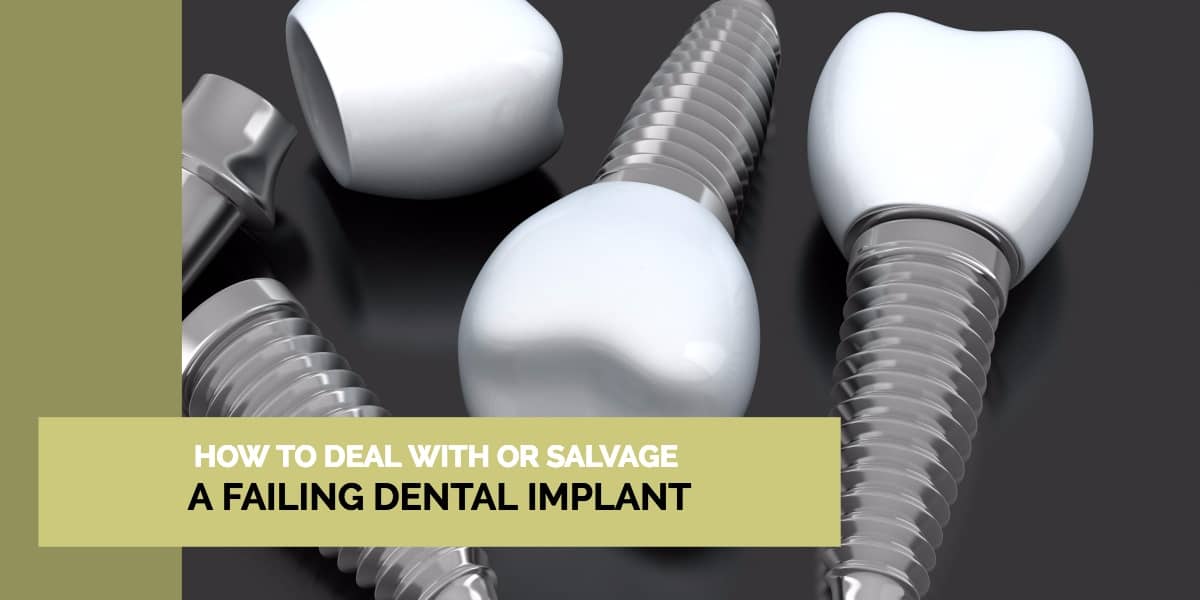
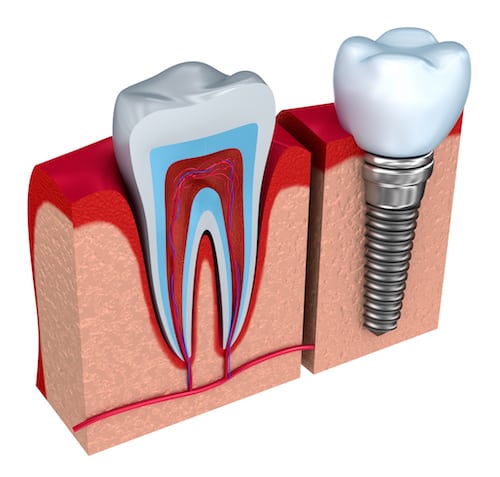






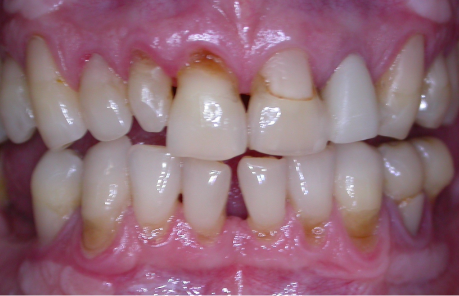
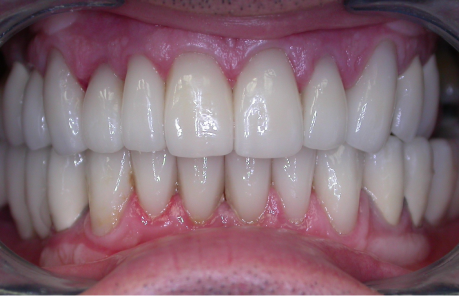
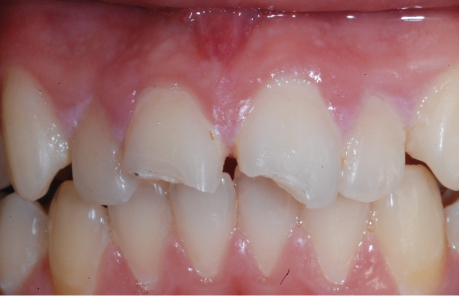
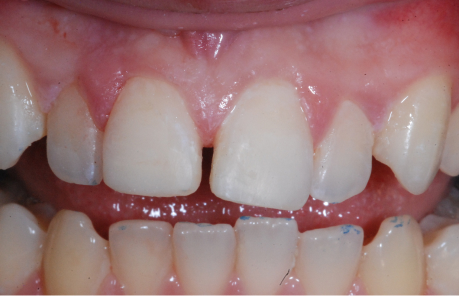
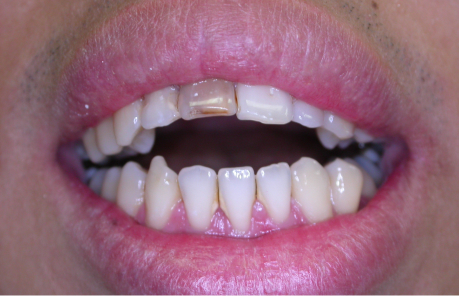
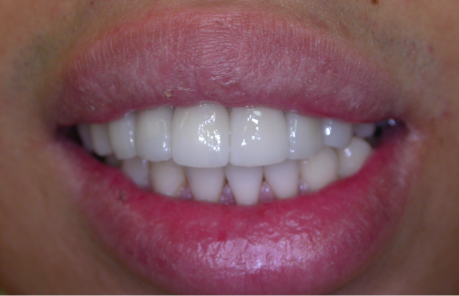
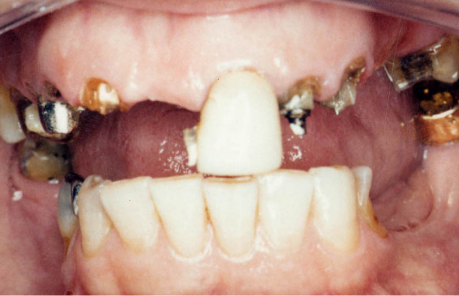
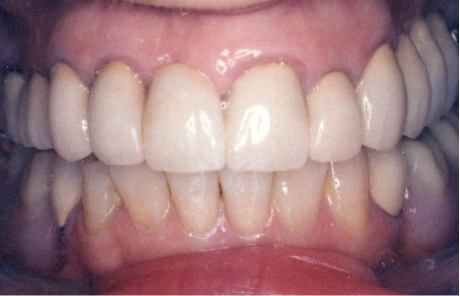
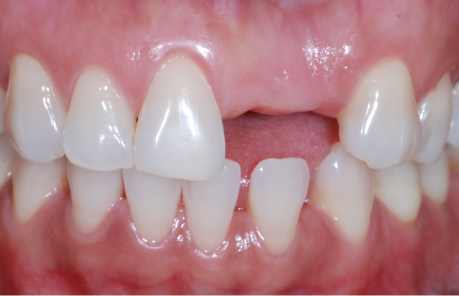
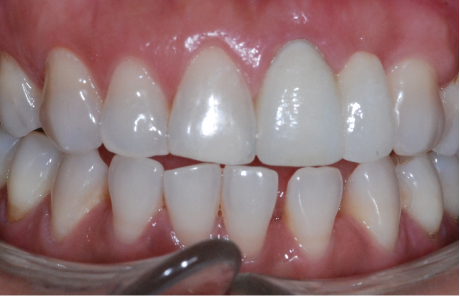

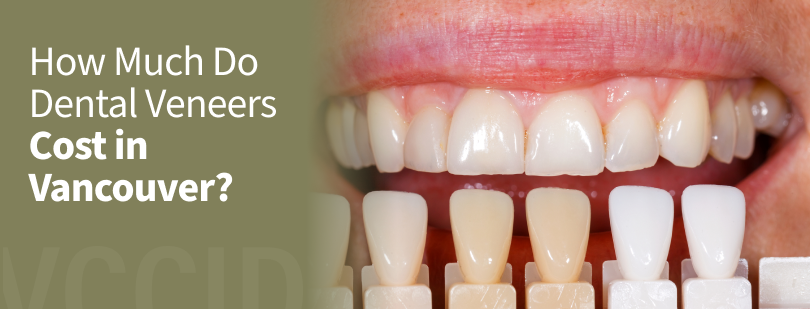
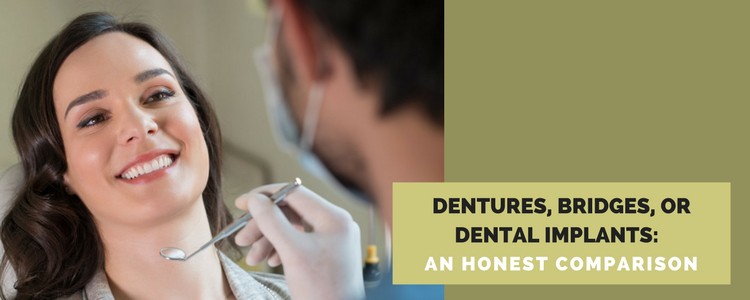



14 thoughts on “How To Deal With or Salvage a Failing Dental Implant”
My implant fell out, or actually it came loose and was still attached to my denture. Now my doctor feels it is necessary to surgically clean area where transplant was, to eliminate possible infection is this a common procedure of transplant failure as well as placing bone graft in affected area.
Hello Deborah,
Thank you for your comment.
Implants can and do fail, unfortunately, even our own natural teeth do not always last. One of the most common reasons for the long-term failure of implants is too much stress on the tooth or the inability to clean around an implant.
Since this was underneath your denture, either one could have been the initiating cause. I don’t know how many implants were holding your denture in or how the denture was designed (the type and retention of clips etc.) But overloading the implant may very well have been the problem. It likely could not hold that amount of weight.
The site should be cleaned and ideally grafted if you wish to replace the implant. Replacing the implant does not necessarily mean failure once again, as long as it is understood what caused the failure in the first place and this is rectified you can achieve long-term success in a previously failed implant site.
I hope this helps to answer your question.
Sincerely,
Dr. Peter Balogh
My front tooth implant is failing. The bone has deteriorated at the front. My Dentist wants to cut open my gum clean and maybe bone graft if possible. I can’t afford to get the work done, how risky is it to leave it? With regular cleaning? What could go wrong?
Any advice would be much appreciated
Many thanks
Hello Anne Marie: I don’t know how much bone is lost and how much infection is present. Not doing anything may lead to more bone loss and bigger problems. Buy a waterpik and use hot salt water around the gums…I have seen some hopeless situation stabilize and even reverse. Besides salt water you can use a 10% Dakin solution in the waterpik…mcuh more effective at eliminating bacteria. You may want to see if someone in our area has a periolase….fairly new procedure but I am seeing some very promising results around failing teeth and implants.
Hopefully this will give you some options
Sincerely
Dr Balogh
Dear Doctor Balogh. I had my front number 8 tooth removed 7 years ago and replaced with an implant and crown. All went well. About 18 months ago my number 7 tooth became infected and also needed to be removed. However, there was bone loss and I needed to get grafting done. The implant was installed 3 month later and initially seemed successful. It began to fail a bout 6 weeks later. And was removed 3 months later completely. The surgeon then did more bone grafting and sealed it for 6 months. An implant was reinstalled and then it was sealed again for another 3 months. Finally, I got my temporary tooth back on. However, with all the surgeries (5 total) My number 8 tooth developed a small amount of daily puss between it and the new number seven. With the various surgeries my gums reseeded and a small void in my gums between the number 8 and 7 developed . It was right up against the number 8 however the new number 7 still seems fine. My surgeon did an exploratory and confirmed a have a small amount of bone loss now on the lower part of the number 8 and inflammation.
He is suggesting we remove the #8 implant and do a bone graft and reinstall. However, the implant is solid. Another suggestion was to remove the tooth/crown and clean the implant, re-bone graft and seal it up for 3 months and then reinstall the tooth. Is it possible to fix the implant now while damage is minimal and keep the tooth on? I’ve been through so much and the the number 8 as well as 7 are still in rock solid. Please let me know.
Hello Steven: My first question would be how severe is the problem. does it bother you, it is visible aesthetically, does it matter to you esthetically? If not, then the next question is how severe is the bone loss, inflammation and infection and is it progressing? If severe and progressing then some intervention will likely be required. Trying to graft the site with the crown in place is difficult if not impossible. The best/most predictable would are to remove the crown, cove the site with gum tissue and then once the gums have healed than graft the site and let it heal again for another 3-4 mths. I believe this is what was recommended.
If the answer to any of the above is no, you could try to manage and reverse the inflammation by buying a water pick and using it daily to flush and clean the pocket around the implant. Use as a minimum, hot salt water as it is antibacterial…a stronger solution is to use a diluted Dakin solution (~0.05% hypochlorite)…the simple method to do this is to take 1 teaspoon of regular bleach (5.25%) and place this in 600ml of water, which is the size of the container in a typical water pick.
I have many of my patients use this and have seen surprisingly good results. If it reduces the inflammation nd bone loss you may not need to do anything more.
Sincerely, Dr Balogh
solution in the
I hope you can help me. I recently had an crown implant fitted after my tooth broke and had to be removed. The problem is now food is collecting under the crown and the only way I can remove the food is if I irregate. That is difficult if I am not at home. I had two implants fitted with one crown a few months ago by the same dentist where I have the same issue. My dentist has told me there is nothing that can be done as it’s my gum that have caused pockets. I am so upset as I now find it difficult to eat on both sides now.
Hello Wendy: Unfortunately it is really difficult for me to comment on whether or not your situation can be improved. Your dentist is probably correct the you may have lost some volume of bone and gum tissue, so there may be some spaces that did not exist in the past, and these spaces could collect food. However, if the contacts between the teeth are not tight (floss should pass with some resistance) then the area will trap food more than necessary. The Solution is to have the lab modify the crowns to increase the contact between the teeth. If the contacts are indeed tight, but food collects at the gum line or underneath the abutment, it may be possible to modify the abutment that holds the crown. The abutment ideally should fit “tight” against the gum tissue such that the area is floss able and yet not so open as to readily collect food. However whether or not it can be done and it will improve the situation is impossible to say without seeing the situation clinically and/or on an x ray. It may require making a brand new abutment and crown and therefore if that is the solution there should be some discussion as to any additional costs. Sincerely, Dr Balogh
Hi – I had a dental implant in August 2018 after having my once healthy tooth get cracked in 2 places from a hard piece inside a rice cake. I just passed the test to see if the implant took which is good but before that the area where the implant was put in would ache from time to time (i do have a temp tooth) and since the test this past Thursday the aching gets more and today it is worse than it’s ever been. The x-ray’s show that everything is looking great and I take great care of my teeth. Any idea why the aching is there? Is it the temporary tooth? I’m cautious about going forward at this point for the custom abutment (sp?) and permanent tooth. Thanks for your help
Hello Karen:
Difficult to say why the area is aching when things look good on an X-ray. Was it a traditional 2D X-ray or a #D cone beam? Sometimes things can look perfectly normal on a tradtional X-ray, yet the 3D image shows things that could be contributing to your symptoms. Normally implants do not ache, unless there is some infection or inflammation going on. Other things to check: the bite as that could also be an issue despite the lack of infection/inflammation (for now the tooth should be totally out of all contact as you bite and as you move from side to side, front to back); the other thing rule out is the adjacent teeth to make sure the pain is not from them. Is there any tenderness to press ont he gum tissue front or back; do the tissues bleed, or is there any pus when you press on the gum tissue…these answers may provide some clues as to the cause.
Unless the temporary is causing some inflammation I would also be cautious about making the final tooth until the problem is sorted out. At the very most a final tooth could be made but should be inserted so that it can easily be removed if necessary.
Hello Dr.Balogh,
Can you please elaborate on how diluted Dakin’s solution supposed to be for water pick?
Say, if I make “full strength” (3 oz. bleach per 32 ounces of water), do I need to mix it as one
part solution per one part water (1:1), or 1:2, 1:4…? Thank you.
Sorry for the late reply…bleach is 5.25% and Dakins solution for wound dressings is 1/10th, or ~0.5%. However for the water pick I recommend diluting the Dakins another 10%, therefore the solution is now 0.05%. Most water picks hold about 20oz or 600ml of water, so assuming yours is the same to get ~1/10th dilution of Dakins a simple way is to fill the water pick and add 1 tsp of 5.25% bleach.
It seems as if implants are not what they seem to be!
Very troublesome for dentistry
Hello William:
The best anyone can do is take care of your natural teeth and get them to last your entire life. Unfortunately that is often not possible, so then you need to consider what to do when a tooth is lost. Implants are not 100% full proof…and the long term success depends on several factors….some of which we can control such as treatment planning, surgical and prosthetic design and protocol, and others which are totally beyond our control….daily maintenance, health, accidents/trauma etc.
I tell all my patients that it is a personal decision and how much value each person places on their oral health, function etc. will determine whether implants are the right solution for that person. And for some of my patients I do in fact tell them that, based on their particular situation they are better off with either a bridge, denture or even a empty spoce.
Sincerely,
Dr Balogh